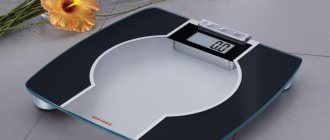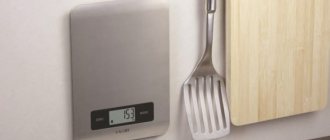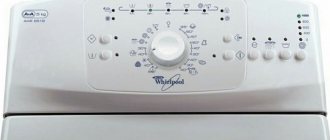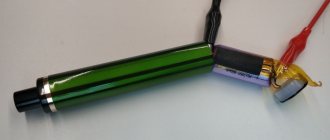Types of scales
Modern household scales come in two types: mechanical and electronic. Mechanical ones have an analog dial, often small, with a division value of 1 kg. Accordingly, the accuracy they provide when weighing is +/- 0.5 kg. For most people who just want to know approximately their weight, this option is suitable. However, for athletes, as well as in medicine, such accuracy is not enough. Electronic scales provide results with an accuracy of up to 100 grams (there are models that show every 10 g). The value is displayed on the screen. Advanced models of scales have additional functions, for example, a built-in calculator/body analyzer, which allows you to calculate the proportions of the body by component composition directly during weighing.
Electronic scales with body composition analyzer
Structurally, electronic scales consist of some kind of sensor and a system for displaying the result. Simple inexpensive copies have a spring sensor, the data from which is digitized and shown on the display. Newer models have a strain converter. Such devices have maximum accuracy, as they are completely electronic. Most often, they have built-in intelligent systems that allow one to determine additional information about the state of the body.
Why electronic scales can “lie”
It happens that several weighings performed in a row have different results. This problem occurs frequently and frustrates users. The reasons for this lie in improper operation of the equipment and even in small nuances in the weighing process.
The main reasons are discussed below.
- The scale must stand on a perfectly level floor. Any unevenness makes the sensor work incorrectly. In this situation, you need to place the scales in another, more suitable place.
- You also need to step on the scales correctly: straight, without pressing or skewing on one side. The feet should be placed parallel to each other, at the same level. It is advisable to stand on the platform at each weigh-in with your feet equally positioned and your weight evenly distributed.
Correct placement of feet on scales
- The legs should be on the platform with the entire surface of the foot. The body is at right angles to the horizontal. Point pressure with your heels and/or toes can significantly distort the result.
- Electronic scales work using sensitive sensors. Negative environmental influences, such as severe changes in room temperature, can affect the accuracy of measurements.
- It has been noticed that near heating devices, scales can also show a result that differs from the real one.
- It is important to properly care for electronic scales. In particular, washing them with aggressive detergents is strictly prohibited. Chemicals can negatively affect sensors and electronics that convert measurement information. Glass scales are best suited for everyday use: they are quite accurate and easy to care for.
Glass scales are easier to care for
Any electronics requires careful use. Libra is no exception. To avoid problems and make measurements as accurate as possible, you should study the user manual.
How to fix the problem
What to do: electronic scales do not show weight correctly? If none of the above reasons apply, then they may be broken. The malfunction may be as follows:
- The batteries have expired.
- The connecting cable comes off - this is the element connecting the electronic board and the display; if it malfunctions, it will distort the data. The board should be pressed closer to the display.
- The relay is faulty, for example, the contacts have become thin.
- The mechanism is damaged due to exceeding the permissible weight or incorrect use of the device.
- Incorrect calibration also leads to data corruption.
Why do electronic scales show different weights? New models must be calibrated in production. Many models provide automatic calibration. However, the measurement accuracy may be compromised if you stand on them several times in a row or move them frequently.
In this case, you can perform calibration yourself. Methods for calibrating scales can be found in the instructions for the device, and this does not require any special skills.
Electronic scales show different weights, despite the fact that they are in good condition and do not need cleaning or calibration? Then follow the following recommendations when taking measurements:
- It is necessary to place the scales only on a flat, hard surface, and always take measurements in the same place.
- It is important to stand on the device correctly during measurement. The feet should be placed parallel to each other. They should not move to the edges or hang off the surface of the scale. You must stand straight and calm. Do not lean against a wall or other furniture.
- All nutritionists recommend weighing yourself in the morning on an empty stomach, without shoes and in a minimal amount of clothing. Weight can change upward over the course of a day due to the amount of food eaten and fluids drunk.
Possible breakdowns of electronic scales
If the floor scales are used correctly, but the result is different each time, they are most likely broken. You can carry out a preliminary diagnosis of the malfunction using the following symptoms.
- The scales do not turn on and no information is displayed on the screen at all. This may indicate that the device is not powered, that is, its power supply (battery) is dead. To solve the problem, it is enough to replace the batteries with new ones. In advanced models, a dead battery produces a specific error code.
Replacing the battery in the scales
- Loss of contact between the scale cable on one side. This element connects the electronic unit and the visualization unit (display). If the cable has moved away from one of the elements, the scale may show strange symbols or nothing at all. You can solve the problem by removing the protective cover and inserting/pressing the board more tightly to the display.
- It happens that the scales show an unexpected result. For example, an adult weighs 15 kg, or weighs 30 kg more than yesterday, without changing in appearance. Most often, it is a matter of wear of the contact elements. In this case, the relay must be replaced.
- The appearance of gaps not provided for by the design leads to damage to the scales. This happens if the device sits on the floor all the time and is not put away in its packaging or cleaned regularly. In this case, the scale must be disassembled and all components carefully cleaned with a soft brush.
- Another reason why scales can “lie” is incorrect calibration of the device. Some models do it automatically when installed on the surface and turned on, others must be configured manually. How to do this can be found in the user manual for a specific device.
Scale calibration
Possible breakdowns
If electronic floor scales show different weights, most likely the device is broken. The type of failure can be determined by certain signs:
- No data on the display - the most likely reason is the lack of constant power. Simply put, the batteries are dead. The batteries must be removed and replaced with new ones. Often this problem appears as an error on the display, so troubleshooting is not difficult. How to replace the batteries in floor scales yourself, read our article.
Outputting an incorrect value
The main problem that arises when using electronic scales is that the device shows different body weights.
For what criteria to choose accurate floor scales, read our article.
Selection Guide
In order to avoid problems with purchased scales in the future, you should listen to the opinions of experts who recommend paying attention to the following points when purchasing.
- If you come across a model with a choice of units of measurement, make sure that kilograms are present in the table.
- For use in the bathroom, you should buy a model with moisture protection.
- For comfortable use, choose floor scales with a rough surface rather than a smooth one.
- When choosing a material, it is better to trust metal models rather than plastic ones.
- Don't skimp on your purchase. Cheap models don't last long, the weight they display isn't always accurate, and you'll end up overpaying for repairs or buying a new scale.
- Be sure to check the measurement accuracy before purchasing.
- When working with scales on a carpet, the calculation error can be up to 10%.
- Do not use models that are not designed for your weight.
- Magnetic radiation from instruments located in the room can affect the quality of weighing, so make sure that the scales are located away from radio equipment.
- When purchasing electronic models, choose a model with 4 sensors. This information is not always indicated on the price tag, so you will have to look at the device’s passport.
- The more built-in functions a device has, the greater the error in their calculations. Try to choose simple and reliable models.
Do not forget that electronic scales operate on batteries, which need to be changed at least once every 6 months.
Why might bathroom scales display the wrong weight?
All instruments have some discrepancies in measurement accuracy (in other words, discreteness). For mechanical ones, the accuracy usually varies within a kilogram. Electronic ones measure with an accuracy of hundreds of grams, but they also have errors. They are most often explained by three possible factors:
- A seemingly branded device may turn out to be a fake. Buy only on the official websites of manufacturers or in partner stores. This not only guarantees quality, but also allows you to get professional advice on choosing the right model.
- Another reason why floor scales do not show the correct weight is poor weighing technique. The fact is that the electronics contain highly sensitive sensors that are located at the corners of the platform and respond to pressure. If you stand on a platform with uneven distribution of body weight, the result will be inaccurate. If there is more pressure on the toes, the readings will be lower, and if on the heels, the readings will be higher.
- The measurement result may not be correct if the device is placed on an uneven surface.
- Finally, the device may simply break down when it malfunctions for some reason. Electronic settings are lost if the room is too humid, hot, or if children are jumping on the device. Then the display shows an “error” or error.
Rules for care and use
For correct operation, it is important not only to choose and use the device correctly, but also to properly care for it. By following a few tips for maintaining your instrument, you will achieve longer life and more accurate weighing:
- Electronic scales are known to be extremely sensitive. Therefore, you should avoid sudden changes in temperature, large amounts of moisture, sudden lowering or shaking, exposure to dirt and direct sunlight.
- Do not place the scale near heating devices.
- It is not recommended to use chemicals to clean the device.
- Avoid contact of various liquids with the surface of the measuring unit.











